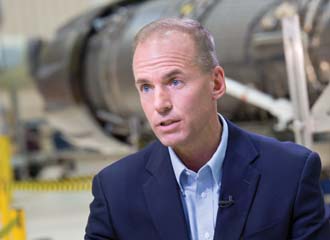Aerospace Giant Beefs Up Defense Business With Mergers, Huge Contract Wins
 |
No one can accuse Dennis Muilenburg of shying away from a big challenge. Muilenburg is the president and chief executive officer of Boeing’s Defense, Space and Security division. The unit counts $32 billion in sales and a global work force of 62,000. He must navigate the division through uncertain waters amid potentially large government budget cuts and increased competition.
Muilenburg, 48, joined Boeing in June 1985 and steadily has moved up its management ranks. He holds a bachelor’s degree in aerospace engineering from Iowa State University and a master’s degree in aeronautics and astronautics from the University of Washington.
But, to understand his approach to dealing with a challenge, one can consider how aggressively Muilenburg can ride a bicycle up a mountain. He and a team of subordinates from Boeing like to hit a torturous 82-mile course known as the Tour de Blast. The event, held annually in late June, draws its name from the fact that cyclists race through a rugged area not far from where a volcanic eruption blew the top off Mount St. Helens in Washington state.
That 1980 incident ranks as the most destructive volcanic eruption in U.S. history. It killed 57 people and destroyed 200 homes, 27 bridges and 15 miles of railroad. Today, life continues to rebound from the tons of volcanic ash that rained down on the mountainside and covered thousands of acres of forest. The area is popular with mountain climbers and is home to the Mount St. Helens Volcanic Monument.
Muilenburg describes the trek through this historic region as a “nice day in the mountains—with a lot of climbing.”
He comes off as nonplussed about the uphill challenge in no small measure because he has done many arduous rides. Muilenburg has bicycled for as long as he can remember. He tries to ride 5,000 miles a year, and he says he is committed to logging roughly 100 miles a week.
As a career Boeing executive, he knows the Seattle and Puget Sound areas well. He is as fond of a 156-mile trek around Mount Rainier as he is a race from Seattle to Portland, which is one-day ride covering some 200 miles.
But in many respects, the Tour de Blast also symbolizes the type of bracing challenges Muilenburg faces at Boeing. He needs both power and endurance as he moves the mammoth defense and space enterprise through a tough obstacle course. Then again, while the Defense Department remains his biggest revenue driver, it finds itself trying to cope with tough budget cuts.
First, the Defense Department must take billions out of its budget in the aftermath of the Iraq withdrawal and because of the nation’s spending crisis. As January 2013 draws nearer, defense policy makers still face the prospect of additional mandatory defense cuts of $600 billion over 10 years if Congress cannot reach a compromise on a plan to reduce spiraling budget deficits.
For his part, Muilenburg says senior Boeing executives anticipated this upheaval as a call to action. They have streamlined operations and shifted some of their more cost-conscious practices from the commercial side over to defense.
“The way we work together across commercial airplanes and defense sectors in terms of leveraging investment and talent is a differentiator for us,” Muilenburg says. “Some of the strength in our commercial market is helping to drive performance on the defense side of the company.
“Also, I think some of what you see reflected there is that over the last couple of years, we’ve taken some very aggressive actions to continue to drive competitiveness and affordability,” he continues. “We’ve seen this defense budget downturn coming; and while it’s a tough environment, it’s one that we’ve been realistic about and prepared for.
“We’ve gotten out ahead of that with some tough decisions on cost-savings measures and trying to drive affordability into every dimension of what we do. And, you see some of that rolling to the bottom line in terms of our financial performance. But it’s also creating value back to our customers with affordable products,” he states.
Earnings for Muilenburg’s division rose 11 percent to $742 million in this year’s first quarter, the last period for which results were available at deadline. This financial performance reflects strong growth for military aircraft, global services and support, as profits from space systems plunged nearly 50 percent.
At the same time, sales in the period got a big boost from the Obama administration’s decision to approve the sale of Boeing-made F-15 fighter jets to Saudi Arabia. The contract is part of Boeing’s renewed emphasis on overseas sales.
Five years ago, foreign sales accounted for just 7 percent of defense revenues. Today, they represent more than three times that amount. Muilenburg says the figure could climb to as much as 30 percent in the next three to five years.
With a total value of $29.4 billion, the Saudi award calls for delivery of 84 new fighter aircraft. The project also includes upgrades, training and maintenance covering 70 aircraft already in the Saudi air force.
“We closed the quarter with $72 billion of defense backlog, and that backlog is well-distributed across our portfolio,” Muilenburg observes. “I think that communicates strength for the future, especially when we’re looking at an uncertain defense budget environment.”
Muilenburg agrees with analysts who point out that Boeing can count on a contract to supply the Air Force with tanker aircraft to smooth out its revenue stream. It calls for production of 179 refueling KC-X jets at a value that could top $35 billion over the next four decades. That contract did prove controversial. Boeing’s final bid came in just 1 percent below that of arch-rival European Aeronautic Defense and Space Company, or EADS.
Just the program’s first phase, which runs through 2017, will add $3.5 billion in sales for the first 18 aircraft. Muilenburg notes that Boeing will make the KC-X on its 767 passenger-jet assembly line, allowing the firm to defray production costs sharply.
“I think that unique approach really drove affordability and is part of the reason why we won,” he explains, adding that it is “the kind of long-term, multidecade program that adds stability to the business.
“And, I’m really pleased to see the progress [Boeing has made] on the program,” he adds. “Just in February, we passed the one-year anniversary of the contract start, and just in the last couple of weeks we completed the preliminary design review. So the program is off to an excellent start. Every single milestone has been completed on schedule to date. We have a great partnership with the Air Force.”
To help grow the business in an uncertain environment, the defense and space unit continues to add new companies to its business portfolio. In just the last three years alone, it has acquired 11 firms concentrated in command, control, communications, computers, intelligence, surveillance and reconnaissance (C4ISR), cybersecurity, unmanned aerial vehicles (UAVs) and logistics services.
All are areas that analysts say will grow much faster in the years ahead than will sales of Boeing’s long list of weapons systems. For example, the Defense Department is stepping up its use of UAVs as well as buying the technology needed to support its prime directive to expand net-centric warfare.
As an example of how Boeing is changing with the times, Muilenburg cites the 2010 purchase of Argon ST. Boeing paid $775 million net of cash acquired to buy the firm because of its C4ISR expertise coupled with strengths in sensors and networks.
“Our preference still is to fuel our growth primarily through organic investment,” Muilenburg explains. “But when we see strategic opportunities to fill a gap or to move more briskly into a growth market with an acquisition, we will continue to use that as one of our strategic tools.
“I would say in the defense budget drawdown that we see, this will create pressure amongst smaller companies, and we see some of that pressure already in our supply chain. And that may create additional affordable acquisition opportunities.”



Comments